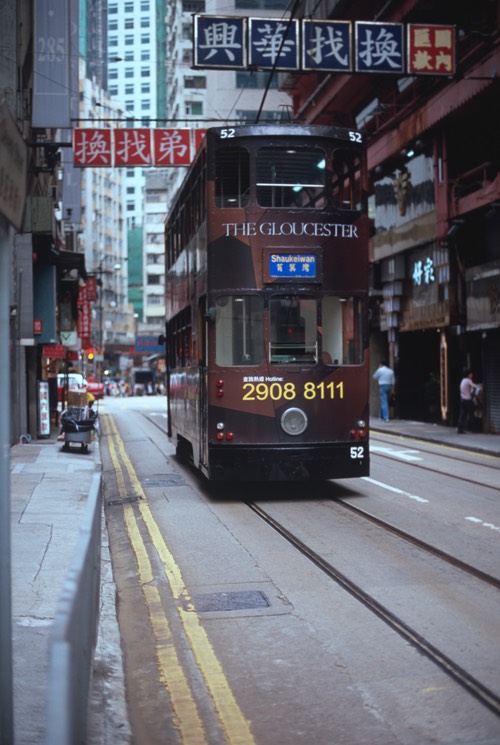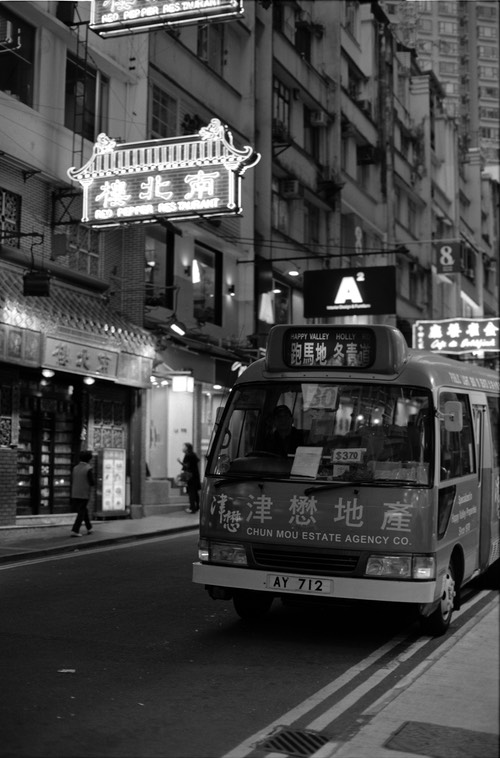
HK Tram - Nikon F6, Nikkor 50mm F1.4G, Fuji Velvia 100
I like to take photos on film. Not because I am too cheap to buy new digital cameras, but because a) I love the old film cameras and the timeless quality they have and b) I really like the results you can get with film. Just like audiophiles will tell you that vinyl records have a unique sound to them that digital cannot reproduce, film can be exactly the same. The way colors and textures are represented is totally different on film - even between different vendors and types of film. Cerainly classic Black and White photography looks considerably better on film, right down to the grain and subtle tones that you can get - which when printed using a darkroom is amplified to make a true work of art.

HK Minibus, Leica M6, Carl Zeiss Sonnar 50mm f1.5 and Fuji ACROS film
But, having gone over to about 50% of my photography being analogue, I have not gone away from managing the resulting pictures digitally. This means that I need to have scanned images for use on the computer. This is where I have spent a considerable amount of time and effort to build a very focused workflow that maximises the quality of the results. I could have used scanning services from the same place I get my films processed (in my case COLORSIX in Centra Hong Kong), but they simply do not do a good enough job - both in terms of the size and quality of the files and in terms of the colr management and details like dust reduction and so on. So I have to do the scanning myself.

Adidas - Hasselblad 500CM and Fuji ACROS 100
I have 2 scanners at home - one a flatbed scanner from Epson called the V700 and the other a specific film scanner from Nikon called the Super Coolscan 9000ED (who thought that name up?) Both scanners are about th ebest you can get for the technology they use, but the results CAN be quite different between them. The Epson has a glass plate between the scanning lens and the film, which tends to make it a bit of a bear to get real sharpness and thus high quality scans, while the Nikon gets super sharp results every time. I use the Epson for large batch scans and to product "contact sheets" of what is on a film, while using the Nikon to scan the "picks" that I need in better quality. This is especially true of 35mm film due to the small size. The Epson can do a very good job of larger 6x6 or 645 film for printing up to 1 meter across.
The real key to all this is the software you use to manage the scans and build a workflow. The software that comes with the Epson (Epson Scan) is not bad as starter software, but is limited in the things you can do with any great control. The nikon software is no longer supproted on a Mac and is even flakey on older PowerPC based machines. The solution to all this is to use one of the 2 high end scanning applications that supprot almost every scanner under the sun. They are called Vuescan and Silverfast. They are both capable of results far better than the software the manufacturer ships with the devices themselves. They are also very complex and difficult to use - particularly in the case of Silverfast, which has been put together (seemingly) with a focus on making it arcane and frustrating. I have almost given up using it for anything other than speicifc scans of color negatives where it can do some amazing things. I stick to Vuescan for the majority of my scanning work. It can produce scans from my 6x6 Hasselblad negatives of around 74 mega pixels in size, far bigger than any digital camera on the market today can generate - that can be printed up to 2 meters across and still look very good.
